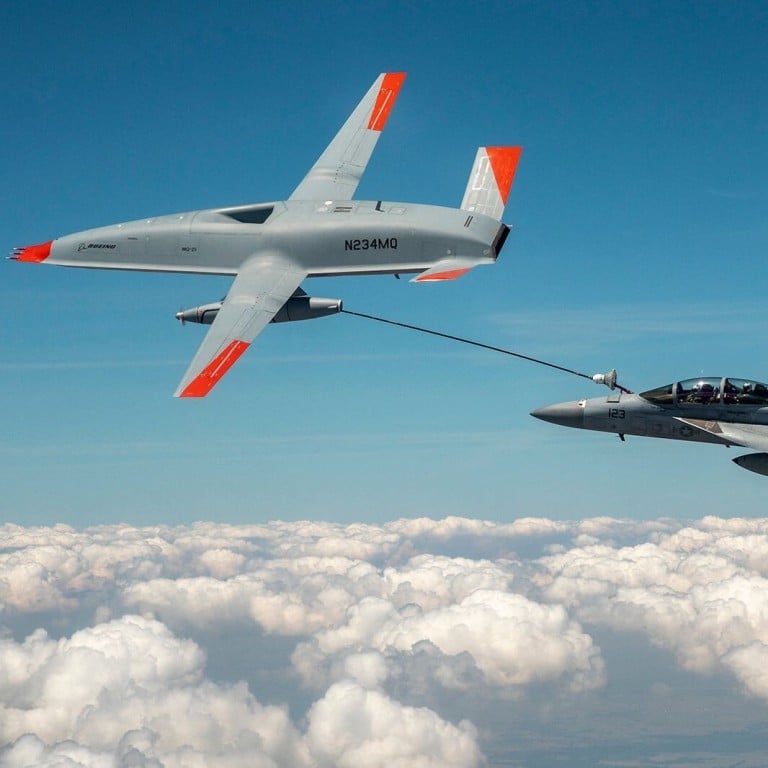
‘Tanker drone’ fuels US Navy fighter jet for first time
- Boeing MQ-25 unmanned aircraft linked up with F/A-18 Super Hornet
- Marks another step in integration of drones into military activities
An unmanned tanker aircraft has successfully refuelled a US Navy carrier-based fighter jet for the first time, the US Navy announced.
A Boeing MQ-25 T1 Stingray test drone refuelled an F/A-18 Super Hornet on Friday near MidAmerica Airport in Mascoutah, Illinois, demonstrating that the new unmanned aircraft “can fulfil its tanker mission,” the US Navy said.
Flying at operationally relevant speeds and altitudes, the F/A-18 flew as close as six metres (20 feet) behind the unmanned aerial-refuelling tanker. The MQ-25 test asset then extend the hose and drogue from the Aerial Refueling Store and plugged into the fighter to transfer the fuel.
US Navy not ready to repair ships damaged in ‘great power conflict’
Rear Admiral Brian Corey, who oversees the Programme Executive Office for Unmanned Aviation and Strike Weapons, said in a statement that the “MQ-25 will greatly increase the range and endurance of the future carrier air wing”.
The MQ-25 will be the world's first operational carrier-based drone. It is expected to not only provide additional intelligence, surveillance, and reconnaissance capabilities to US Navy aircraft carriers but also significantly extend the reach of carrier-based fighter jets, a necessity given the changing capabilities of America's rivals.
In 2013, a prototype stealth drone, the Northrop Grumman X-47B, made its first landing on a US aircraft carrier.
China's growing arsenal of anti-ship missiles with the potential to threaten US naval assets has forced the US Navy to think carefully about how it might employ its carriers in a great-power conflict.
With unmanned aerial refuelling assets like the MQ-25, which can carry up to 15,000 pounds of fuel, the US Navy can free up manned assets and engage an enemy at a distance without putting its carriers in harms way.
Captain Chad Reed, programme manager for the US Navy's Unmanned Carrier Aviation programme office (PMA-268), said that the recent test was “a significant and exciting moment for the Navy and shows concrete progress toward realising MQ-25's capabilities for the fleet”.
In addition to supporting F/A-18s, the MQ-25 will also be able to support EA-18G Growler electronic-warfare aircraft and F-35C Lightning II fighter jets.
US Air Force hypersonic missile fails to launch in first flight test
The US Navy awarded Boeing a US$805 million contract for the MQ-25 aerial refueler in August 2018, and the unmanned aircraft made its first flight one year later in September 2019.
The MQ-25 flew for the first time with the aerial refuelling hardware required for its primary mission in December. The latest test followed 25 T1 flight that tested the aircraft and the refuelling technology, as well as simulations.
Boeing said that flight testing will continue and that later this year a test asset will be sent to Norfolk, Virginia, for deck handling trials on a US Navy aircraft carrier.
Leanne Caret, president and CEO of Boeing Defence, Space & Security, said in a statement that “this history-making event is a credit to our joint Boeing and Navy team that is all-in on delivering MQ-25's critical aerial refuelling capability to the fleet as soon as possible”.
The US Navy intends to integrate the MQ-25 into a carrier air wing and achieve initial operational capability by 2024. It also plans to make sure all Nimitz- and Ford-class aircraft carriers are MQ-25 capable.
Read Business Insider’s story.

